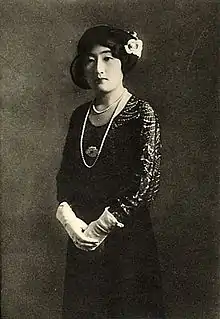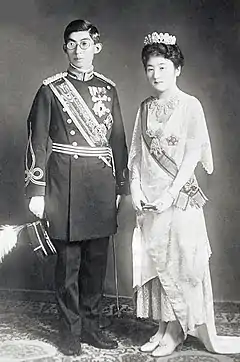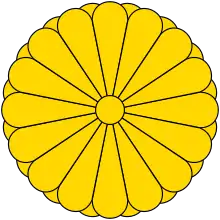Setsuko, Princess Chichibu
Setsuko, Princess Chichibu (雍仁親王妃勢津子, Yasuhito Shinnōhi Setsuko, born Setsuko Matsudaira (松平節子, Matsudaira Setsuko); 9 September 1909 – 25 August 1995) was a member of the Japanese Imperial Family and the wife of Prince Chichibu, the second son of Emperor Taishō and Empress Teimei. Setsuko was a sister-in-law of Emperor Shōwa and an aunt of the Emperor Akihito.
| Setsuko | |
|---|---|
| Princess Chichibu | |
 Princess Chichibu, c. 1928 | |
| Born | Setsuko Matsudaira (松平節子) 9 September 1909 Walton-on-Thames, England, United Kingdom |
| Died | 25 August 1995 (aged 85) Tokyo, Japan |
| Burial | Toshimagaoka Imperial Cemetery, Bunkyo, Tokyo |
| Spouse | |
| House | Imperial House of Japan |
| Father | Tsuneo Matsudaira |
| Mother | Nobuko Nabeshima |
Early life
Setsuko Matsudaira was born on 9 September 1909 in Walton-on-Thames, England, into the prominent Matsudaira family. Her father, Tsuneo Matsudaira, was a diplomat and politician who later served as the Japanese ambassador to the United States (1924) and later to Great Britain (1928), and still later, Imperial Household Minister (1936–45, 1946–47). Her mother, Nobuko Nabeshima, was a member of the Nabeshima family. Her paternal grandfather, Katamori Matsudaira, was the last daimyō of the Aizu Domain and head of the Aizu-Matsudaira cadet branch of the Tokugawa. Her maternal grandfather, Marquis Naohiro Nabeshima, was the former daimyō of the Saga Domain. Her mother's elder sister, Itsuko (1882–1976), married Prince Morimasa Nashimoto, an uncle of Empress Kōjun. Despite her prestigious heritage, Setsuko was technically born a commoner, but both sides of her family maintained kinship with distinguished kazoku aristocratic families close to the Japanese Imperial Family.
From 1925 to 1928, Setsuko was educated at the Sidwell Friends School in Washington, D.C. while her father was ambassador to the United States.[1] Setsuko was fluent in English and was sometimes considered to be a Kikokushijo. Upon her return to Japan, Setsuko was chosen by Empress Teimei to marry her second son, Yasuhito, Prince Chichibu, despite the fact she was a commoner. Setsuko married the Prince after her uncle, Viscount Morio Matsudaira, formally adopted her, thus removing the status incongruity between the prince and his bride.
Marriage

On 28 September 1928, aged 19, Setsuko wed Prince Chichibu, and became Princess Chichibu. The bride and groom were eighth cousins, thrice removed, as both were descended from Nabeshima Katsushige, the first lord of Saga.[2] Prince and Princess Chichibu had no children, as Princess Chichibu's only pregnancy ended in a miscarriage. However, by all accounts their marriage was filled with love and happiness for each other.
In 1937, the prince and princess were sent on a tour of Western Europe which took several months. They represented Japan at the May 1937 coronation of King George VI and Queen Elizabeth in Westminster Abbey and subsequently visited Sweden and the Netherlands as the guests of King Gustav V and Queen Wilhelmina, respectively. Princess Chichibu stayed in Switzerland while her husband met Adolf Hitler in Nuremberg at the end of the trip. Princess Chichibu felt a great love for the United States and for England and, as an anglophile, was greatly saddened by Japan's entry into the Second World War on the side of the Axis powers.
Widowhood
After the Prince's death of tuberculosis in 1953, Princess Chichibu became president of the Society for the Prevention of Tuberculosis, honorary president of the Britain-Japan Society, the Sweden-Japan Society, and an honorary vice president of the Japanese Red Cross. The Princess made several semi-official visits to Great Britain and Sweden.
Death
Princess Chichibu died from heart failure in Tokyo on 25 August 1995, shortly before her 86th birthday. Princess Chichibu's autobiography, which was published posthumously as The Silver Drum: A Japanese Imperial Memoir, was translated in English by Dorothy Britton.
Titles and styles
| Styles of Princess Chichibu | |
|---|---|
 Imperial Coat of Arms | |
| Reference style | Her Imperial Highness |
| Spoken style | Your Imperial Highness |
Setsuko was styled as "Her Imperial Highness Princess Chichibu" after her marriage.
Honours
National honours
- Grand Cordon of the Order of the Precious Crown (28 September 1928)
Foreign honours
King Gustaf VI Adolf of Sweden invested her with the Grand Cordon of the Order of the Seraphim on 8 April 1969. On 23 July 1962, she became an Honorary Dame Grand Cross of the Order of the British Empire. On 9 October 1978, Princess Margaret, Countess of Snowdon (on behalf of Queen Elizabeth II) invested Princess Chichibu as an Honorary Dame Grand Cross of the Order of St Michael and St George.
 Sweden : Member of the Royal Order of the Seraphim
Sweden : Member of the Royal Order of the Seraphim United Kingdom : Honorary Dame Grand Cross of the Order of St Michael and St George
United Kingdom : Honorary Dame Grand Cross of the Order of St Michael and St George United Kingdom : Honorary Dame Grand Cross of the Order of the British Empire
United Kingdom : Honorary Dame Grand Cross of the Order of the British Empire
Ancestry
| Ancestors of Setsuko, Princess Chichibu[2] | |||||||||||||||||||||||||||||||||||||||||||||||||||||||||||||||||||||||||||||||||||||||||||||||||||||||||||||||||||||||||||||||||||||||||||||||||||||||||||||||||||||||||||||||||||||||||||||||||||||||||||||||||||||||||||||||||||||||||||||||||||||||||||||||||||||||||||||||||||||||||||||||||||||||||||||||||||||||||||||||||||||||||||||||||||||||||||||||||||||||||||||||||||||||||||||||||||||||||||||||||||||||||||||||||||||||||||||||||||||||||||||||||||||||||||||||||||||||||||||||||||||||||||||||||||||||||||||||||||||||||||||||||||||||||||||
|---|---|---|---|---|---|---|---|---|---|---|---|---|---|---|---|---|---|---|---|---|---|---|---|---|---|---|---|---|---|---|---|---|---|---|---|---|---|---|---|---|---|---|---|---|---|---|---|---|---|---|---|---|---|---|---|---|---|---|---|---|---|---|---|---|---|---|---|---|---|---|---|---|---|---|---|---|---|---|---|---|---|---|---|---|---|---|---|---|---|---|---|---|---|---|---|---|---|---|---|---|---|---|---|---|---|---|---|---|---|---|---|---|---|---|---|---|---|---|---|---|---|---|---|---|---|---|---|---|---|---|---|---|---|---|---|---|---|---|---|---|---|---|---|---|---|---|---|---|---|---|---|---|---|---|---|---|---|---|---|---|---|---|---|---|---|---|---|---|---|---|---|---|---|---|---|---|---|---|---|---|---|---|---|---|---|---|---|---|---|---|---|---|---|---|---|---|---|---|---|---|---|---|---|---|---|---|---|---|---|---|---|---|---|---|---|---|---|---|---|---|---|---|---|---|---|---|---|---|---|---|---|---|---|---|---|---|---|---|---|---|---|---|---|---|---|---|---|---|---|---|---|---|---|---|---|---|---|---|---|---|---|---|---|---|---|---|---|---|---|---|---|---|---|---|---|---|---|---|---|---|---|---|---|---|---|---|---|---|---|---|---|---|---|---|---|---|---|---|---|---|---|---|---|---|---|---|---|---|---|---|---|---|---|---|---|---|---|---|---|---|---|---|---|---|---|---|---|---|---|---|---|---|---|---|---|---|---|---|---|---|---|---|---|---|---|---|---|---|---|---|---|---|---|---|---|---|---|---|---|---|---|---|---|---|---|---|---|---|---|---|---|---|---|---|---|---|---|---|---|---|---|---|---|---|---|---|---|---|---|---|---|---|---|---|---|---|---|---|---|---|---|---|---|---|---|---|---|---|---|---|---|---|---|---|---|---|---|---|---|---|---|---|---|---|---|---|---|---|---|---|---|---|---|---|---|---|---|---|---|---|---|---|---|---|---|---|---|---|---|---|---|---|---|---|---|---|---|---|---|---|---|---|---|---|---|---|---|---|---|---|---|---|---|---|---|---|---|---|---|---|---|---|---|---|---|---|---|---|---|---|---|---|---|---|---|---|---|---|---|---|---|---|---|---|---|---|---|---|---|---|---|---|---|---|---|---|---|---|---|---|---|---|---|---|---|---|---|---|---|---|---|---|---|---|---|---|---|---|---|---|---|
| |||||||||||||||||||||||||||||||||||||||||||||||||||||||||||||||||||||||||||||||||||||||||||||||||||||||||||||||||||||||||||||||||||||||||||||||||||||||||||||||||||||||||||||||||||||||||||||||||||||||||||||||||||||||||||||||||||||||||||||||||||||||||||||||||||||||||||||||||||||||||||||||||||||||||||||||||||||||||||||||||||||||||||||||||||||||||||||||||||||||||||||||||||||||||||||||||||||||||||||||||||||||||||||||||||||||||||||||||||||||||||||||||||||||||||||||||||||||||||||||||||||||||||||||||||||||||||||||||||||||||||||||||||||||||||||
Patrilineal descent
| Patrilineal descent |
|---|
|
Setsuko's patriline is the line from which she is descended father to son. The existence of a verifiable link between the Nitta clan and the Tokugawa/Matsudaira clan remains somewhat in dispute.
|
References
- Roosevelt, Eleanor (May 28, 1953) "My Day". The Eleanor Roosevelt Papers Digital Edition
- "Genealogy". Reichsarchiv (in Japanese). Retrieved 5 September 2017.
Further reading
- Princess Chichibu. The Silver Drum: A Japanese Imperial Memoir. Global Books Ltd. (UK) (May 1996). Trans. Dorothy Britton. ISBN 1-86034-004-0
- Ema, Shuichi. Chichibu no Miya Hi Setsuko no shogai. Kaibushiki Kaisha Kuppon (1996). ISBN 4-88975-601-9 (Japanese)
- Fujitani,T. Splendid Monarchy: Power and Pageantry in Modern Japan. University of California Press; Reprint edition (1998). ISBN 0-520-21371-8
- Lebra, Sugiyama Takie. Above the Clouds: Status Culture of the Modern Japanese Nobility. University of California Press (1995). ISBN 0-520-07602-8
External links
| Wikimedia Commons has media related to Princess Chichibu. |
- Their Imperial Highnesses Prince and Princess Chichibu at the Imperial Household Agency website
- "The Silver Drum"
- "Floribunda Roses"
